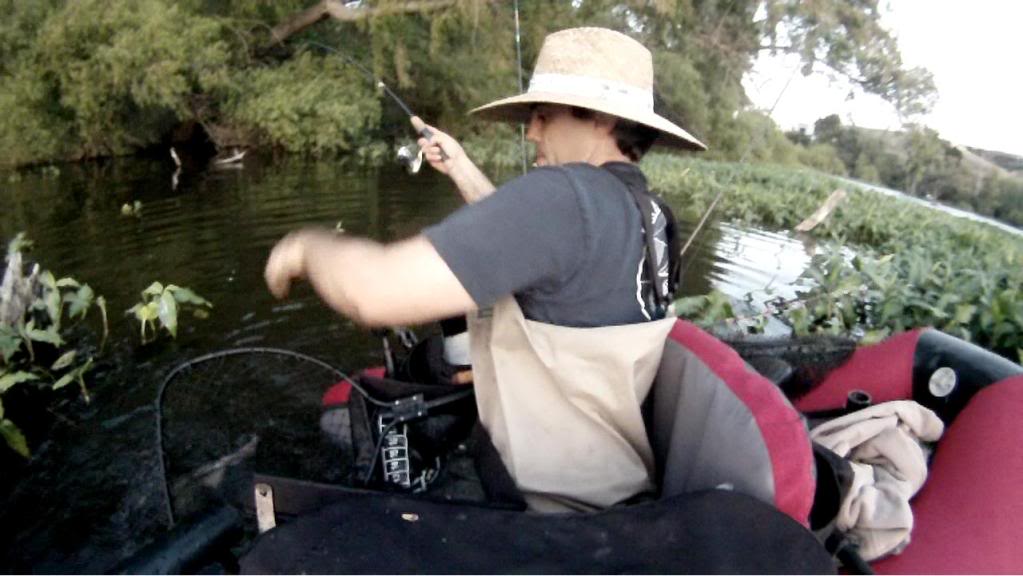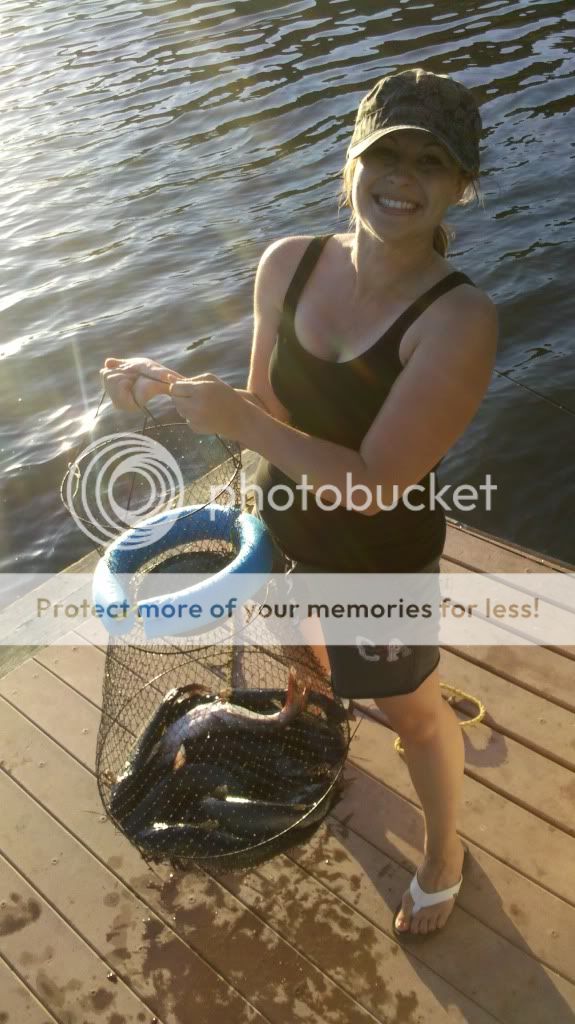Re: catfish killin
Saturday, July 9, 2011 6:00 PM
From:
“geoffrey”
To: “Fishinglakes.com” <[email protected]>
Yea thats cool cuz its the truth. I cant wait to go again, last time I took my 5 year old nephew and he is hooked, next will be the 8 year old neice. thanx again.
From: Fishinglakes.com <[email protected]>
To: geoffrey
Sent: Saturday, July 9, 2011 5:57 PM
Subject: Re: catfish killin
Man that’s great!!
I would like to us your testimonial on the web site, is that OK?
Thanks!!
Sent from my iPhone
On Jul 9, 2011, at 5:54 PM,
geoffrey wrote:
I read Aaron`s tutorial for catfishing because last year I got skunked more often than not and now i`ve limited 4 times in a row. It helped big time and I expect to kill`em again next time.Thanks Aaron,………geoff

A “how-to” in the basics of catching CATFISH!!!!
It’s summer time…you need new techniques!!
Aaron Sappenfield
Staff Writer / Lake Guide / Avid Fisherman
Santa Ana River Lakes – Corona Lake
7/1/11
It’s 8 pm on yet another beautiful summer evening that could never be adequately described, but needs to be experienced to know just how wonderful the arena of southern California can be. In the virtual tackle shop that spans most of the rooms in my humble abode, the light tackle and fishing rods hang in their racks, the plastic trout worms, mini jigs, and garlic dough baits lie dormant in a canvas lined tackle box, and yet, missing from the confines of my house are my heavy freshwater rods, float tube, headlamp, and fish basket. Additionally, the freezer is suddenly missing a portion of the previously stockpiled mackerel rations, there is a mini worm farm being harvested in the garden, and most importantly, I’m gone, out of the door and on a new mission…
Sitting on the lake long after the sun has set, a cone of light shining from a small headlamp perched atop my head breaks through the thick blanket of darkness that bathes the surrounding landscape. My hands work to bait a hook in the small luminescent circle while my float tube sits idle on the mirrored water’s surface. Ten feet in front of me is a bundle of submerged timber evidenced only by a few inches of wood thrust out of the water and into the cool summer air. Turning off the light emitting diodes strapped to my head, I open the bail on my reel and release my bait directly into an assortment of dense structure…this is where “the creatures” live. Within less than a minute, a small *tap* on my line is almost immediately followed by my stout rod being bent to the reel seat. The “zzzzzzzzz” of my drag destroys the silence of the night and the direction in which this fish is pulling tells me one thing; this fish wants only to get back into the “tackle trap” and wants absolutely NOTHING to do with me. While keeping pressure on the fish, between the large headshakes of my opponent I can feel the line rubbing against waterlogged bark. Navigating the underbrush, I click my headlamp back on and sweep around the timber to find an angle that I can utilize to force the fish out of its hole. Coming around and suddenly gaining line, I no longer experience the worried feeling of line-on-structure…the game has now become one of tug-of-war in open water. It must have something to do with the silence of the night, but few things seem as loud as a fish breaking the surface after sunset. With its tail whipping through the atmosphere, the boom of large splashes oscillate between closer and farther from net as this fish and I swap the leading role in this game. Minutes later it appears that this game is through and this time I’m not the one being pulled into the mud. Thrusting the net at the tired fish, the noisy whiskered beast is enveloped in the nylon mesh and lifted out of the water. The now audible croaking and intermittent thrashing in the net marks the end of another insanely fun battle, a battle that continues all summer long against some of the most amazing fish to grace our local lakes…the catfish.
Putting a bend in the rod…with 3 fish already in the net!!!

Put simply, catfish are a remarkable fish. The rigor stored in the heart of each and every whiskerfish is just astounding. You would be hard pressed to find another fish with a stronger will to live than a catfish and it’s that drive that makes them an incredible creature to catch. It’s that same drive that can also make them incredibly difficult to catch! It’s not the bait that is tricky. Nor are the spots impossible to get to. And it’s not even that the catfish only bite at weird hours of the day! The difficulty lies in putting the puzzle pieces together. Assembling the bits and pieces of information in a manner that makes these fish want to play. When you accomplish this goal, you will experience some of the most amazing fishing that southern California has to offer. 5 minute limits, fish that crush the double digit mark and approach the triple digits, and some of that infamous catfish “tug” that we all can’t get enough of. And thus the point of this article…
This article will give you the bits and pieces of information that you need to get out there and catch our whiskered foes. Books have been written on the subject that do not cover everything and thus this article will NOT be comprehensive! But what it will do is give you a starting point. A place for you to dive in with some solid knowledge in your arsenal that is tried and true to consistently produce fish. So with that, let’s get to it! And the best place to start is with the fish themselves…An old wise man said, “To catch the fish, you must know the fish.” Pretty wise if you ask me so let’s get to know these whiskered beauties!
My friend…the catfish!
When you look at a catfish, you are looking at a machine that is perfectly engineered for everything this fish does. This fish is basically one big sensory organ that is designed to eat everything in its path, to be somewhat picky about doing so, and to be constantly weary of its surroundings. The Lakes stock 2 types of catfish…the channel cat:

And the Blue cat:

Both the channels and the blues grow to great sizes, but the blues are the creatures from the deep that can outweigh some of the adults on your boat! Amazing fish that will simply scare you with their size when they come boat or shoreside.
It’s absolutely nothing new to note that catfish spend a lot of time feeding along the bottom. What you may not realize is just how perfect these fish are setup for that task. Beginning with the tip of their faces, you may note in the picture above that the mouth is tucked slightly on the underside of the sleek head of the fish, perfect for eating food that rests below the fish. That sleek head can be used as a shovel in the mud to exhume prey that are immediately vacuumed up into the fishes mouth or even to dig the fish its own personal palace. The barbels (or “whiskers”) are extremely sensitive sensory appendages that commonly trace the lake bottom looking for any sort of food source, be it live or dead! Interestingly, evidence of this bottom tracing behavior extends back at least 400 million years, and thus these fish have had plenty of time to perfect the art!! Each of these features paints a picture of catfish being a bottom feeding scavenger, which is true, but that does not fully nor adequately describe the behavior of these fish. Catfish are indeed scavengers but they are also predators that will gladly eat a live or fresh dead bait. I’ve been in business with the cats on everything from topwater plugs to suspended live crawdads to floating powerbait and even mini-jigs and trout spinners. So just like any business, getting bit by catfish is commonly most dependent on 3 things…LOCATION, LOCATION, LOCATION!!!
A channel cat resting with its barbels just gently touching the bottom. No doubt this fish can feel and will trace every nook and cranny in every small pebble that line this aquarium.

Besides the obvious bottom placed mouth and faced donned with whiskers, catfish have a number of other adaptations that make them not only truly amazing fish, but give us critical clues as to where we can find them. One thing to note is that catfish are negatively buoyant. That means that while placed in “idle”, catfish will not float, but will sink. Thus the cats will often sit not only directly on the bottom, but also in small holes made along steep areas of the shorelines or directly on top of bits and pieces of submerged structure. Rarely (but occasionally they do) will you find them cruising along mid water column. Using their bony heads, these fish can and do exhume their own dwellings particularly along steep, clay-rich shorelines. This is especially true during spawning season (late spring – early summer) when these fish are looking for a place to store their eggs where they won’t be consumed by some of their fellow underwater comrades! (side note: catfish are not like other fish in that they do NOT become increasingly active in their feeding during the spawn. In fact, catfish put protecting their eggs much higher up on the priority list than actually feeding themselves, and it’s usually the male catfish that does the protecting. Thus, getting spawning catfish to bite requires bringing the food to them rather than enticing them to go get the food through thick scent trails and the like. But put your bait in front of a spawning catfish and you are placing your bait in front of what is without a doubt a hungry fish!) The absence of scales and the slime produced by catfish means that they can get into the tightest of quarters and remain there with minimal damage to their bodies. This also means that when they are dug in tight, they will NOT come out except for the perfect baits and the most well-placed casts….That’s a huge hint in case you missed it! All of this means that you need to be in tight to the “structure”. Structure can be the bottom (yup, the bottom is structure!), a log, a thick grass bed, a catfish burrow or any other solid piece of equipment that these fish can associate themselves with. Thus, drift fishing a chunk of the tastiest bait in the world 5’ below a bobber in the middle of the lake probably still isn’t going to produce. But take even a mediocre bait and put it where the fish are, directly in their faces, and it’s going to be game on!
Catfish “grapplers” exploiting the muddy banks where catfish have dug themselves in. There are two options when going after cats burrowed in tight to structure: 1) you can throw a bait in their face to try and coax them out. 2) you can reach your hand in there, hope for a catfish instead of a finger breaking/taking turtle, and yank the bugger out. These guys are going for option #2 but I think I’ll stick to option #1!!!

Perhaps one of the most amazing features of catfish is the one that you will never see…Catfish have an amazing ability to hear. An anatomical feature called the “Weberian apparatus” connects the auditory system in catfish with their swim bladders. Basically, this means that even the smallest sounds originating from outside of the fish’s body passes through the gas bladder and causes it to vibrate like a speaker which in turn can be “heard” by the fish. Picture standing next to a drum at the L.A. Philharmonic and having someone tap the drum head with their mallet. It’s highly likely that you won’t hear it, especially with all of the other musicians tuning their instruments. Now picture placing your head inside of that same drum and with the same mallet tap, you’ll swear that your head is about to explode!! That’s exactly what is going on inside of the catfish. Add this amazing feature (which is specific to the Superorder that catfish belong to, by the way!) to a pronounced lateral line in catfish and you have a hearing machine!!
I emphasize the catfish’s ability to hear for a few reasons. First, all too often I see the entrance of a boat announced to a spot by the launching of an anchor that appears to be performed like it is an Olympic event, scored on distance and splashdown size. I also commonly note that this event is followed by the “14’ foot back and forth sprint” or the “dance competition” where anglers (commonly children) see exactly who can stomp the loudest on the floorboard of their vessels. There is also the “4-ounce torpedo sinker hucking” competition that’s purpose is to get as far out there as possible “because that’s where the fish have to be” and must do so by providing maximum disturbance to the water. While these games may be a ton of fun, the sensory machines that catfish are want nothing to do with them. Gently placing your anchor in the water, telling your kids to take a seat, and lightening up on the weight (this in particular for a multitude of reasons) can really improve your odds of catching fish. You venture to a new spot because that is where you believe the fish are. No point in getting there and chasing them all away! Absolute silence is virtually impossible so set yourself up just within casting distance of where you want to fish instead of directly on top of it. If possible, cast beyond your honey hole and then reel your bait into it. You are stalking these fish, and like any good stalker will tell you, silence is golden! Right, stalkers???
In discussing catfish anatomy, we’ve learned a few things. Catfish are both scavengers AND predators that are amazingly perceptive of the conditions in their environment. During the spawning season, catfish will bury themselves in preexisting structure or may even make their own and thus, catching them requires that a bait be precisely and stealthily placed very close to their domain. And while there, keeping quiet is a critical component to your success. There is so much more that can be said about the anatomy of these amazing fish but we must move on! And where we’ll move on to next is onwards and upwards into tackle!!!
Rods, reels and rigs, OH MY!!
Catfish rigs are not all that complex yet getting the right equipment will minimize the amount of fish you lose. Since you will spend your time soaking bait, this is not like trout where a rod’s action is as important for enticing a fish to bite as well as having the ability to drag the thing in. With catfish, your rod’s main jobs will be to: 1) be sensitive enough to feel the bite 2) be stout enough to drag the fish out of large cover and 3) be capable of absorbing the LARGE headshakes coming from the fish. Thus, for me personally, I really like medium action, 4-10 pound rated fiberglass rods for this application. Fiberglass rods have extremely flexible tips combined with incredibly strong backbones. Fiberglass is also typically a bit cheaper than graphite which is nice when they get beat up in the trees all season! I do carry a graphite rod with me on most occasions but I always find myself reaching for the glass when I get tight in the nooks and crannies.
I carry both conventional and spinning setups with me out there and once again, all of my reels are shimano. A smooth drag is an absolutely critical component of fishing for catfish as you’ll like be fishing lighter line than you should be in heavy structure and with strong fish. I will typically not go over 10 pound test unless I’m specifically targeting the bigguns (which is a completely different ballgame!). Braided line is not a bad idea either and I strongly recommend POWER PRO! Power pro is really strong and of equal importance, SHARP stuff, capable of cutting through all types of vegetation. I typically tie the braid to a small barrel swivel and use a short 1-2 foot leader of 6-10 pound fluorocarbon or monofilament.
The size hook you will need will depend on the bait you are using, however, there is no reason to drop down below a size 6 baitholder hook. Typically, for my nightcrawler rigs I’ll use a size 6-4 baitholder hook and with chunks of mackerel I’ll size that up to a size 4 hook or larger. Catfish are generally not “hook shy” meaning that you can leave plenty of the hook exposed without fear of not getting a strike because of it. So the appropriate sized hook is the smallest size hook you can get that allows the barb of the hook to be exposed. See the illustration below for more detail on this shtuff!

What you use for weight, if you use any at all will depend on your method (e.g. drifting vs. sitting on anchor) as well as the bait that you are using. If you are using a bait that sinks on its own, there may be no need for a sinker at all. Running a line straight to a hook is commonly referred to as “flylining”. Flylining is a popular approach as with the absence of weight, the fish feels less resistance upon strike. The moment a catfish feels resistance from a line pulling in the opposite direction, the fish will usually drop the bait. So if you need to use a sinker (e.g. you’re using a floating bait or you will be drift fishing), a common option is to use a sliding egg tied above a swivel. The sliding weight will often (but not always) stay in place when the bait is taken, allowing the line to easily pass through it. No weight lifted, no weight felt! When I use a sinker, I’ll typically use a 1/8-1/2 ounce slider above a small barrel swivel. I will then attach my leader to the barrel swivel and I’m good to go!
The final rig we’ll talk about is the 2 hook rig. Yup, I said it…you can use two hooks on a single line and it’s a fairly easy rig to set up, and who doesn’t want to double their odds? You’ll need to know one key knot…The Dropper Loop. The dropper loop is one of my most commonly used knots in both the salt and freshwater. It’s a fast knot to tie that can be used in all sorts of applications from fishing seabass, rock fish, to yup, you guessed it, CATFISH! The addition of a loop in your line allows you to make an additional connection above the end of your line. The loop can be used to connect a sinker or yup, you guessed it again, a hook. The video below will walk you through how to tie the dropper loop. After you have place the loop in your line, you simply push the loop through the eye of the hook and then pull the entire hook through the loop. Yup, really that simple!
There are a million more ways to rig your setup but these basics will get you going. Ask around the Lakes and people will tell you all kinds of new rigs from triple swivels to sliding bobbers, etc etc.. All of these can be effective when used at the right time in the right place. But the setups outlined above will get you started. And just for good measure, here’s a diagram that illustrates the rigs we just discussed.
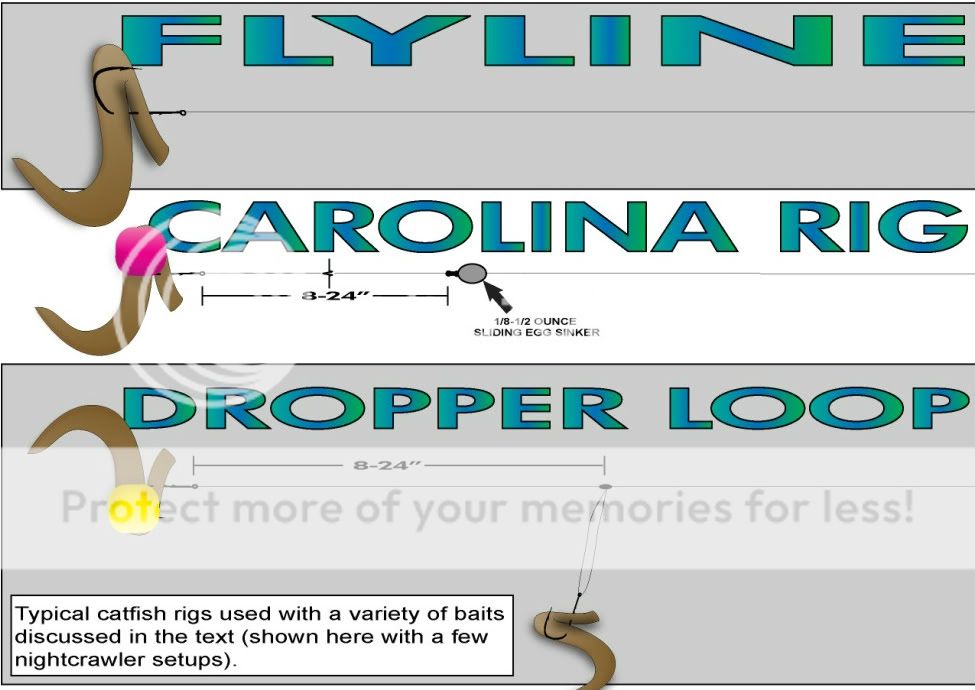
For tasting so good, good grief what these catfish will eat!!! BAIT!!
Catfish baits are legendary. Truly. Some recipes handed down generation after generation seem to be better protected than the secrets of Area 51. Talk to any angler about catfishing and it’s highly likely that you’ll hear tales about the “stinkiest bait in the world that granddaddy used to make in his shed”. Ask for the recipe and I hope you don’t mind being laughed at!
Truth is that the diversity of catfish baits available is incredible. This is NOT just a game of stinkbait and sticking to those baits that smell like you stole them from a month old crime scene severely limits your arsenal. Not to mention that going home smelling like a dumpster is commonly completely unnecessary!! Fact is that by utilizing the diverse array of baits available and in some cases combining them can be much more effective than simply seeing what makes you want to hurl in the tackle shop.
For our purposes, I’m going to divide baits up into 4 categories: 1) live bait, 2) cut/dead bait, 3) dough bait, and 4) punch/dip baits. We will leave the last two for another article for sake of some form of brevity to this shindig! No doubt there are some techniques and baits that are out there that don’t fit into these groups, but these are what I utilize out at the Lakes. We’ll go through each one in detail so that you know what to look for when selecting your bait and also how to deploy them when out on the water.
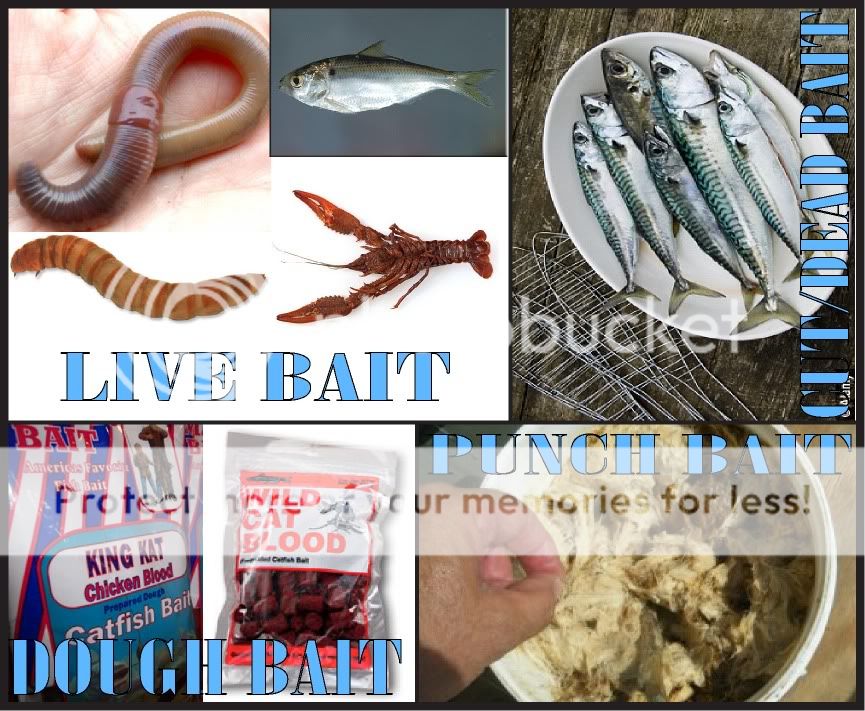
Before we get started, I wanted to briefly discuss the one bait that does not fit into any of the categories above; the marshmallow. The marshmallow is an amazing tool for fishing cats. It’s not that catfish like to sit around the campfire and make smores, but the marshmallow serves as a fantastic apparatus for making any bait from nightcrawlers to shrimp float. This is often important when fishing in close to fallen timber or other elevated structure. In the “bushes”, the cats are only rarely sitting directly on the bottom so having your bait up a bit is incredibly advantageous and adding a single ‘mallow to your hook can accomplish that goal. MONEY SAVING TIP!!: “fishing” marshmallows are pretty darn expensive. They are commonly “anise” flavored and come in the perfect size for baiting your hook. However, when using the ‘mallow, I’ve had near equal success on the small marshmallows that you can buy from your local grocery store (shown below). You can get a GIANT bag for less than a buck which is far better than the $4+ you pay for the fishing specific version. Plus, if you’re out there and get hungry, marshmallows are a low fat snack and anise ‘mallows are pretty disgusting (it was a mid-evening dare during a slow time in the bite)!!

LIVE BAIT
As previously stated, catfish are indeed predators and they will without a doubt pounce on a lively bait. Live bait includes worms of a variety of types, mealworms (not actually a worm but a beatle larvae believe it or not! Don’t believe me? Leave a carton in your tackle box for a few weeks and see what you get!), shad, crawdads, (live shad and crawdads can’t be used at the Lakes) etc.. Perhaps the most successful live bait known to man for catching your standard 2-3 pound channel cat and even the occasional double digit fish is the nightcrawler. And beyond catching cats, tilapia, crappie and trout will pound the nightcrawlers too! If I’m drifting multiple rigs, one of them will almost always have some kind of nightcrawler setup on it.
I discuss nightcrawlers first not only because they are so productive, but also because the way they are rigged are a solid foundation for how virtually all other baits can be rigged. In other words, they are a GREAT starting point for your catfish endeavors!! Nightcrawlers can be rigged to be fished right on the bottom, they can be suspended from a bobber, they can be inflated or added to a marshmallow so that they float and the list goes on!! Add a little bit of scent to these critters and good grief, this stuff is like catfish crack! ADDICTIVE!!!
The diagram below outlines a few rigging methods for nightcrawlers. Further details are included in the text attached to the illustration. Again, the nightcrawler in the illustrations can be swapped out for a variety of both live and dead baits. You may not need to “half” other types of baits, but the general setups always apply. Mix it up until you find what works and then you got ‘em!!
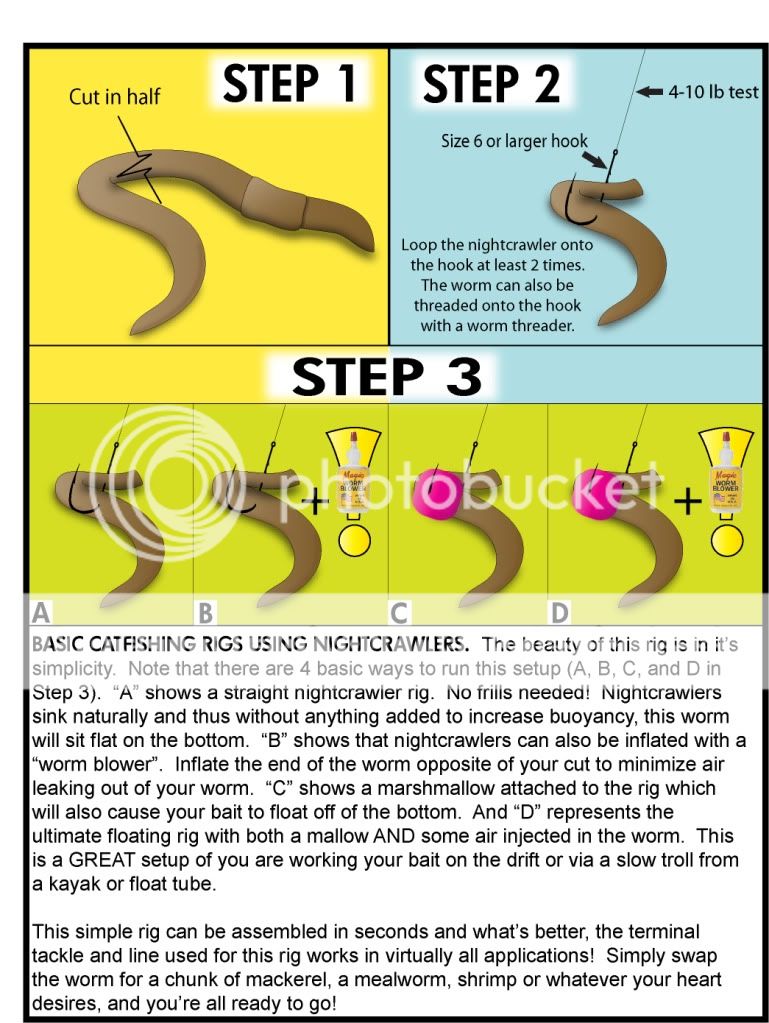
Crayfish, shad and other types of live bait are far more expensive than a carton of nightcrawlers and to be honest, they are often more hassle than they are worth plus, it is against most Lake’s rules to import live fish for bait, or crayfish. Keeping them alive both in the livewell and on the hook is difficult. Both shad and crayfish can sometimes be caught while you are out there at the Lake, but again, I haven’t found that extra time to be much worth it out at the Lakes.
Cut/Dead Bait
Cut bait is another popular option when fishing for cats. The most popular cut or dead baits at the Lakes are mackerel, bonito, anchovies, sardines, shrimp or chicken livers. The Lake Tackle Shops have plenty of frozen mackerel if you don’t bring your own. Mackerel is an extremely oily fish and thus casts a wide scent trail in the water. It’s cheap if you want to buy it and easy to get fresh if you want to go catch it. Simply take a sabiki rig down to the pier (no license required at most piers, CHECK YOUR LOCAL REGULATIONS!), drop it down and you’ll pull them up by the truck load. The most common species of mackerel that you will catch are the Pacific Mackerel (“Greenbacks”)…

but these little buggers are also great… Locally they are called Spanish Mackerel, and at times they are very abundant in southern OC and south. They are killer bait at La Jolla.

They both work fantastic and will keep well frozen in a Ziploc bag in the freezer.
Using cut mackerel is an absolute piece of cake. I typically use a size 4 or larger hook and because the cut bait sinks naturally, I will often fly line the bait. The diagram below shows how it can be cut and also shows where the oiliest portion of the fish is located…in the belly! You don’t have to be a sushi chef to use mackerel effectively, but having a bit of an idea of how to slice and dice things up and where the choice cuts are located sure can help!
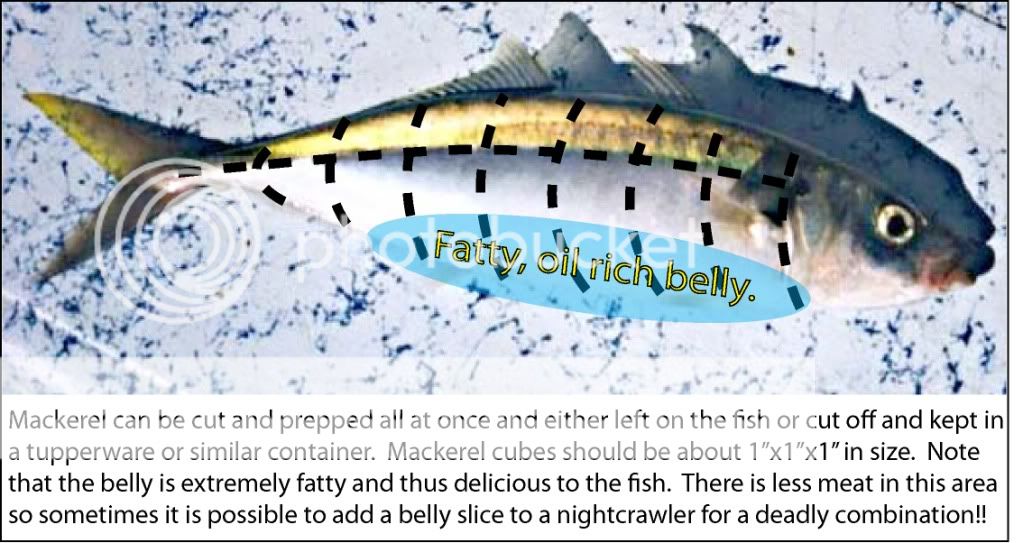
Shrimp is another really commonly used bait. It works very well for catfish and for the sturgeon in the Lakes. One important thing to note is that you want RAW shrimp and not the cooked variety. Though you typically only use the tails, a lot of catfish anglers will buy whole “head on” shrimp, split the tail off of the shrimp and squeeze the juices from the head onto the tail as a bit of an attractant. To hook up the shrimp, simply stick the hook through it in the center of the tail. Yup, that easy!!
You now have the rig, the bait, and an idea of catfish behavior but you’re still missing one vital piece of the puzzle…WHERE TO FIND THE FISH!! Well, that’s where we’re headed next in the final segment of this how to.
Finding the kitties…
All trout season long we troll, drift, and anchor in various places in open water with more of a care for the position of the thermocline, depth contours, and oxygen availability than for structure such as drowned trees. However, come catfish season, you HAVE to severely change gears and begin to consider every nook, every cranny, every crevice that a fish can squeeze into because those are the places these fish are going to be.
Identifying structure is easy when a dead tree is sticking out of the water but this is actually more of the rarity than it is the rule. If you solely relied on looking for structure protruding from the water as your sole source of information, you’d miss out on 99.9999% of what is going on under the water! You don’t need a $1000 sonar to see the timber (though they help!), you just need a bit of an attention to detail. Polarized sunglasses can often reveal submerged timber just below the surface. Paying attention to the contour of the shoreline can also reveal what’s going on below. Trees overhanging the water are undoubtedly going to drop some of their branches in the water so you can be fairly confident that this is where catfish may be hanging. If any of these scenarios are associated with an inlet, WORK THEM THOROUGHLY. Elevated oxygen levels are commonly associated with water inlets and elevated oxygen often means elevated feeding activity from the fish. Hit these spots hard and you can almost be assured you will find the fish that want to play.
I will often tell people to “work the structure” and will subsequently watch them plop their anchor about 20 yards from said structure. That’s about 18 yards too far away! When I say work the structure, I mean it. Get in close and personal. Toss your bait into those places where you’re fairly certain you won’t be able to get it out. Sometimes you won’t but many times you will and on at least a few of those occasions, you’ll be rewarded with a fish coming out with it!
We’ll use the image below to highlight what it means to work the shoreline…
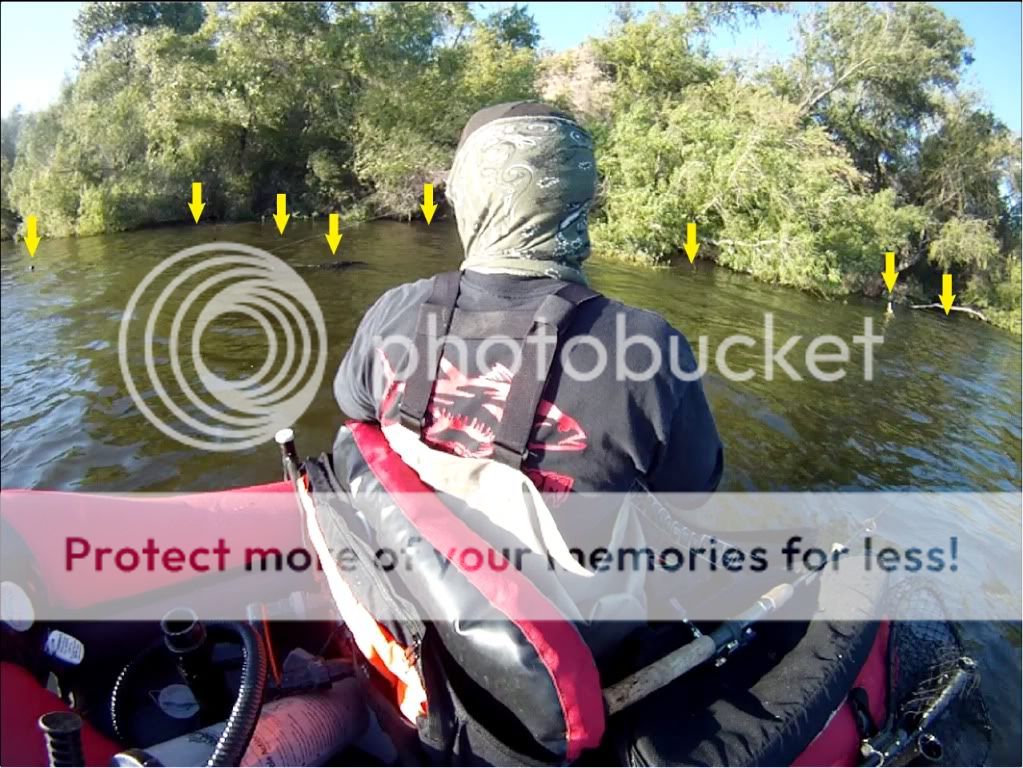
In the image above you see me set up about 5-10 yards off of the shoreline. I stopped at this spot on the lake for all of the reasons marked by the yellow arrows…a TON of structure and all kinds of places capable of holding fish. And it just so happened that this spot in particular happened to be holding a BOATLOAD of fish! Casting into about 1/2 of the spots marked by the yellow arrows meant a fish every time. Casting into one of the other spots meant sitting there idle with absolutely nothing going on. So a 50/50 shot at catching fish. If I had casted one rod into a single spot marked by a yellow arrow and let it soak there all day long, I would have had about a 50% chance of getting bit. But by casting at each of these spots, letting it soak for no longer than 5 minutes and then moving on, I was able to get my limit easily in short order. In fact, by the count on my GoPro camera, 5 seconds after the cast in the above image was made…
BENDO!!!
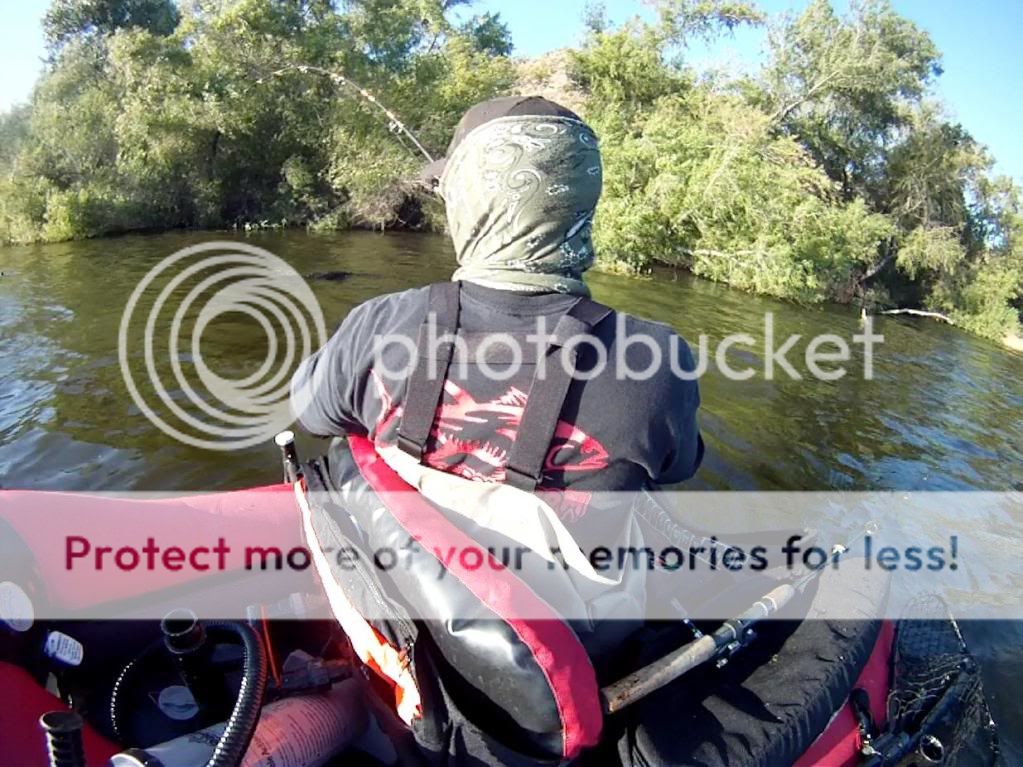
Getting in tight and identifying those places that are most likely to be holding fish is KEY to seriously getting into the catfish. Drifting the barren middle of the lake is key to catching a good nap! Fishing structure is particularly important during these early summer months as the fish are less active or are going through the spawning process. But as stated above, put it in their faces and they won’t be able to resist it!!
Summing it all up
I’ve always made it a personal goal of mine to try my best to have as many fishing outlets as possible. Doing so has enabled me to all but cut, “I can’t wait until…” completely out of my vocabulary and replace it with, “Let’s go fish for _________ today!!” In that catfish are amazing creatures and that we have some of the best catfishing in the world right in our backyard, you can bet that you’ll be seeing me out there all season long tugging on these strong fish and filling my plate with their delicious fillets! And I DO mean delicious. If you have not eaten any of the “SilverCats” they stock in the Lakes, you are in for a treat. My wife will even eat it! Mild, sweet, no fishy taste, absolutely delicious. Watching the sun set from on the water in a t-shirt, under a straw hat and with a SERIOUS bend in the rod just cannot be beat in my opinion and I look forward to it each and every year! And with the tools listed above, you’re ready to dive in and join me!!
For those shore fishermen out there, yea this article was written in mind of the float tuber or boater when I discuss LOCATION – LOCATION – LOCATION, and fishing the obvious structure like trees and logs, but everything else applies if you are fishing from shore. Anywhere you fish, you can and will find areas from shore that hold fish better than others. We call them honey holes. You need to cast around and try different spots. Cast short, cast long, and then right and left both short and long, but don’t continually cast in the same spot you have not caught any fish, you must change it up. Another piece of advise is to move around the Lakes until you find the fish. Don’t just set in one spot and expect the fish to come to you, especially in the beginning of the season when the water is cooler. In cooler water, catfish are less active and tend to ball-up in a school and seek the cover of structure and numbers for protection (now you know why I fish in the structure). How many times have you seen one guy catching all the fish and those around him catching nothing? He’s on a honey hole or on a school of balled-up catfish. You will see this often in the beginning of the season. However when the water warms and the metabolism of the catfish goes into the aggressive mode, they will no longer ball-up in schools, but will fan out everywhere across the Lake in search of food or prey. This is when, fishing from the shore where there is (sometimes) less structure will be productive. The good news is, the water is getting warmer every day, and the shore fishermen have been doing very well.
 Trino Magana- La Habra Trino Magana- La Habra6-25-11 |
 Santiago Palacios Santiago PalaciosWest Covina 6-25-11 |
This article is insanely long. The longest I’ve written by far and yet we’ve only scratched the surface. The point of all of this was to provide you with the means to get on the fish. An ignition to the fuse that with one solid hookup will explode into a full blown obsession…just like it has in me!!! Catfishing is truly unique…unique in it what it offers and unique in what the anglers offer it. The diversity of styles and techniques is just a small part of what makes this game so fun. So develop your style. Maybe it will completely disagree with mine! But perfect it until you are consistently catching fish…then share what you learn with me because if there’s anything that I’ve learned while catfishing it’s that you never EVER have things 100% figured out…and thank God for that!!!!!!!!
As always thanks and I really can’t wait to see you guys out there!!!
Aaron
UPDATE: honey-do’s…
Time for an on the water update!!! My wife demanded that I take her fishing after I came home ranting and raving about my last outing (yeah, I’m a lucky guy!). Well, turns out the girl can fish! Double limits loooong before the sun will go down!! Too much fun!!



